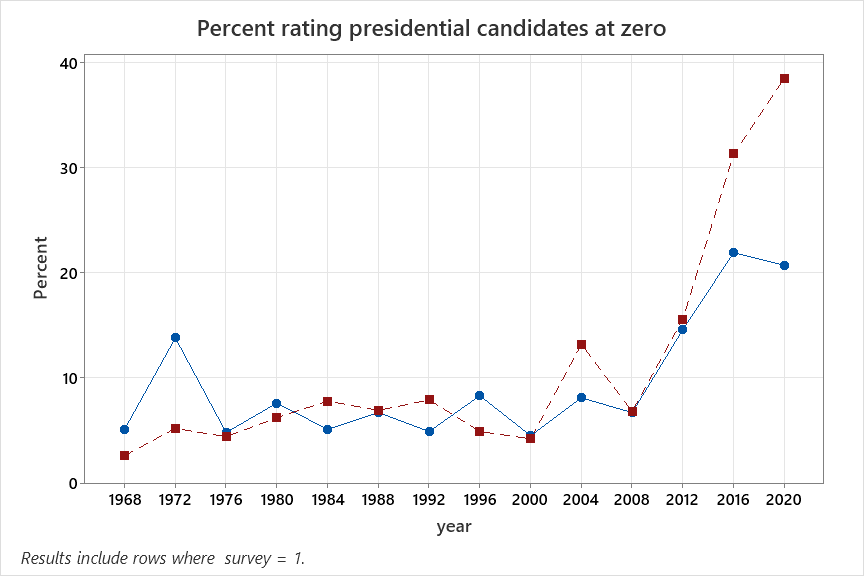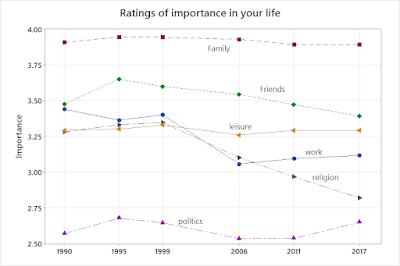I have an account on Truth Social, and I check it from time to time to see what Donald Trump is saying. He recently posted a story from Breitbart about a survey by Rasmussen Reports. According to the story "more than 1-in-5 voters who submitted ballots by mail say they did so fraudulently." This isn't just some Twitter "poll"--Rasmussen has decent record of accuracy in predicting elections (a B rating from 538)--so it deserves a closer look.
The survey found the 30% of the sample said they voted by mail in the 2020 election. Those who said they did were asked "did a friend or family member fill out your ballot, in part or in full, on your behalf" (19% yes); "did you fill out a ballot, in part or in full, on behalf of a friend or family member, such as a spouse or child?" (21% yes); "did you cast a mail-in ballot in a state where you were no longer a permanent resident? (17% yes); "did you sign a ballot or ballot envelope on behalf of a friend or family member, with or without his or her permission?" (17% yes). Everyone was asked three additional questions whether "a friend, family member, or organization, such as a political party, offer to pay or reward you for voting?" (8% yes); whether "you know a friend, family member, co-worker, or other acquaintance who has admitted to you that he or she cast a mail-in ballot in 2020 in a state other than his or her state of permanent residence?" (10% yes); and whether "you know a friend, family member, co-worker, or other acquaintance who has admitted to you that he or she filled out a ballot on behalf of another person?" (11% yes).
Rasmussen didn't release the original data, but they provided a detailed breakdown of responses. In looking at that, I noticed something strange--people who said they voted for Trump were likely to say that they had done these things. For example, among people who voted by mail, 26% of Trump voters and 14% of Biden voters said that a friend or family member had filled in their ballot. A larger fraction of Biden voters voted by mail (36% vs. 23%), so overall, .23*.26=.060 or 6% of Trump voters and .36*.13=.050 or 5% of Biden voters said that someone else had filled in their ballot. The total percent of voters who answered yes on each question:
Trump Biden
Someone else filled in your ballot 6.0% 5.0%
You filled out someone else's 6.9% 4.7%
Signed someone else's 5.3% 4.0%
So if you accept the data, Trump voters were more likely to engage in "fraud" than Biden voters.
For the questions asked of everyone:
Offer of reward 6% 9%
Know out-of-state voter 13% 8%
Know someone who filled out other's 12% 9%
There was also another odd pattern in the data. For all of the questions, people in the youngest age group (18-39) were more likely to answer yes--a lot more likely. For example, 33% of people aged 18-39, 9% of people aged 40-64, and 1% of people aged 65% said that they had signed someone else's ballot. Of course, there is sampling error, but these aren't tiny groups--there are roughly 100 absentee voters in each age group. Since people in the youngest age group were more likely to have voted for Biden, the tendency for Trump voters to be more likely to report irregularities would be even stronger after controlling for age. The age differences are also present in the questions asked of everyone--19% of 18-39 year olds, 7% of 40-64 year olds, and 3% of people over 65 said they knew someone who admitted casting a ballot in a state of which they weren't a resident.
How can you explain the age differences? I doubt that there has been a dramatic increase in propensity to violate the rules for mail in ballots (and to tell friends, family members, and acquaintances that you've violated the rules) across the generations. Rasmussen has a statement on their methodology that might provide an answer. Their sample is mostly obtained by random-digit dialing of phone numbers, but "to reach those who have abandoned traditional landline telephones, Rasmussen Reports uses an online survey tool to interview randomly selected participants from a demographically diverse panel." Unlike most survey organizations, Rasmussen doesn't use live interviewers--there's a recorded voice and people answer by "press 1 for yes, 2 for no....." I suspect that people are more likely to give a false answer with this format than when speaking to a person, and because Trump has been saying that there was fraud in mail voting, Trump voters may have wanted to help give evidence of fraud.** This tendency is likely to be stronger in the panel--since they are regularly asked to do surveys (and probably are generally more online), they are likely to have a better sense of how the results will be used. People without landlines tend to be young, so the panel probably makes up a much larger share of the 18-39 group. So my hypothesis is that many of the "yes" answers are a result of Trump voters (especially in the panel) giving answers that they think will help to make Trump's case that there was a lot of fraud in the election. Another factor is that people in the online panel are presumably given some compensation for participating in the surveys, so they may rush through without paying much attention. Most organizations make some effort to identify people like this and remove them from the sample, but they are usually pretty crude and Rasmussen doesn't say anything about whether and how they do it. So some of the "yes" answers, especially in the youngest cohort, may be people who are essentially answering at random.
*The "no longer a permanent resident" question was left out of the table.
**The question about who you voted for was asked before the questions on voting irregularities--that is, people answered it before they knew what the survey would be about.












